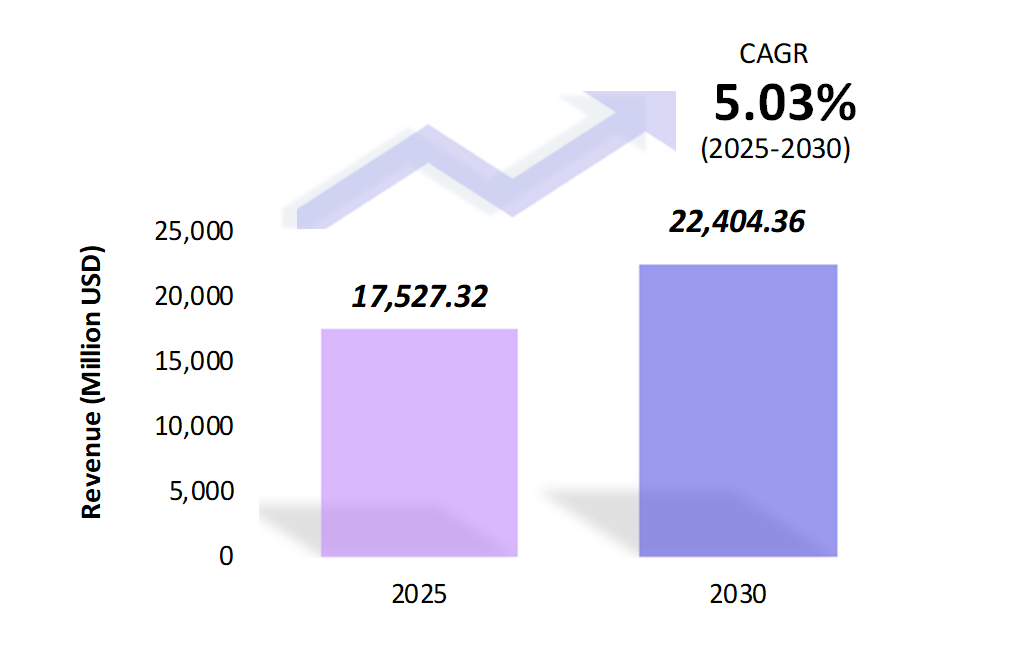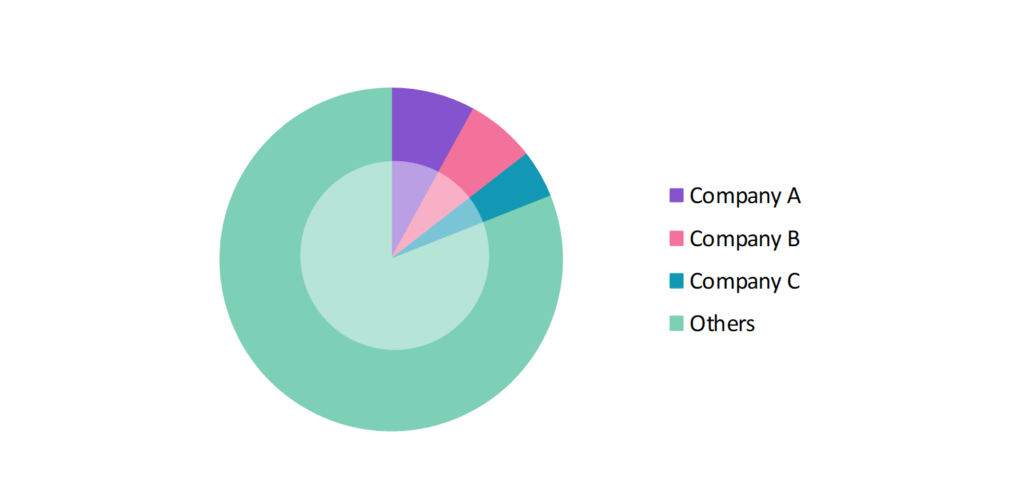Motion Control Market Outlook: Size, Share, Trends & Growth Analysis (2024-2029)
The market report presents a thorough analysis segmented by Product (Motors, Drives, Position Controls, Actuators & Mechanical Systems, Sensors and Feedback Devices); by End User (Electronics & Semiconductors, Pharmaceuticals/Life Sciences/Medical Devices, Oil & Gas, Metal & Mining, Food & Beverage, Others); by Geography (North America, South America, Asia Pacific, Europe, The Middle East, Africa).
Outlook

- The motion control market is estimated to be at USD 17,527.32 Mn in 2025 and is anticipated to reach USD 22,404.36 Mn in 2030.
- The motion control market is registering a CAGR of 5.03% during the forecast period 2025-2030.
- The global motion control market is expanding due to growing automation across manufacturing, automotive, aerospace, and healthcare industries. Motion control systems enhance precision, speed, and reliability in various industrial processes, including robotics, conveyor systems, and CNC machines.
Request a free sample.
Ecosystem

- The global motion control industry participants are always developing strategies to preserve a competitive advantage.
- These companies focus on research and developments, investments, innovations, and product launches by offering new-generation motion control systems for automotive, aerospace, and manufacturing industries.
- Several important entities in the motion control market include Siemens AG; Schneider Electric; Mitsubishi Electric Group; ABB Group; Omron Corp.; and others.
Ask for customization.
Findings
| Attributes | Values |
|---|---|
| Historical Period | 2019-2023 |
| Base Year | 2024 |
| Forecast Period | 2025-2030 |
| Market Size (2025) | USD 17,527.32 Mn |
| Market Size (2030) | USD 22,404.36 Mn |
| Growth Rate | 5.03% CAGR from 2025 to 2030 |
| Key Segments | Product (Motors, Drives, Position Controls, Actuators & Mechanical Systems, Sensors and Feedback Devices); End User (Electronics & Semiconductors, Pharmaceuticals/Life Sciences/Medical Devices, Oil & Gas, Metal & Mining, Food & Beverage, Others); Geography (North America, South America, Asia Pacific, Europe, The Middle East, Africa) |
| Key Vendors | Siemens AG; Schneider Electric; Mitsubishi Electric Group; ABB Group; Omron Corp. |
| Key Countries | The US; Canada; Mexico; Brazil; Argentina; Colombia; China; India; Japan; The UK; Germany; France; UAE; Saudi Arabia; Egypt; South Africa |
| Largest Market | Asia Pacific |
Get a free quote.
Trends
- Adoption of Smart Manufacturing Solutions: The emphasis of Industry 4.0 has led to the integration of motion control systems in intelligent manufacturing environments. These systems have Internet of Things (IoT) sensors and artificial intelligence algorithms for enhanced data analytics and predictive maintenance. In 2023, Siemens introduced its “Digital Twin” motion control solution, enabling manufacturers to simulate and optimize machine operations before deployment.
- Miniaturization and Compact Solutions: There is a growing emphasis on smaller and more compact motion control systems that offer high performance while saving space. These systems are gaining emphasis in industries like medical devices and consumer electronics. In 2023, Parker Hannifin introduced a series of miniaturized servo motors and controllers designed for precision applications in compact spaces.
- Integration with Advanced Sensors: The integration of motion control systems with advanced sensors such as LiDAR, vision systems, and 3D cameras enables more accurate and efficient machine operations. This trend is especially prominent in the autonomous vehicle and aerospace sectors.
Speak to analyst.
Catalysts
- Increasing Adoption of Automation in Manufacturing: The growing need for efficiency and precision in manufacturing processes drives the adoption of motion control systems. Automation is critical in reducing production times and enhancing product quality.
- Rising Demand for Electric Vehicles (EVs): The shift towards electric vehicles (EVs) is boosting demand for motion control technologies in EV manufacturing, especially in battery assembly and drivetrain production. In 2023, Tesla and other significant automakers invested in advanced motion control systems to streamline EV production processes.
- Expansion of Aerospace and Defense Sector: Motion control systems are critical in aircraft systems, missile guidance, and satellite operations. The defense sector is investing in advanced motion control for drones, targeting systems, and other applications. In 2023, Lockheed Martin adopted new motion control technologies to enhance the performance of its defense equipment.
Inquire before buying.
Restraints
- High Initial Costs of Implementation: Motion control systems, particularly advanced ones integrated with AI and IoT, can be costly. Small and medium-sized enterprises (SMEs) often face financial barriers when adopting these systems.
- Technical Complexity and Integration Issues: Integrating motion control systems with existing equipment involves intricate technical challenges, including compatibility issues and precise calibration. This complexity necessitates skilled personnel with expertise in both software and hardware and a considerable time investment to ensure seamless operation and optimization, ultimately impacting project timelines and costs.
- Regulatory and Compliance Issues: Motion control systems, especially those used in healthcare and defense, are subject to stringent regulatory requirements. Adhering to these regulations can be time-consuming and costly for manufacturers. In 2023, aerospace manufacturers such as Lockheed Martin and Thales faced delays in certifying new motion control systems due to stringent FAA regulations.
Personalize this research.
Hotspot

Explore purchase options.
Table of Contents
| 1. Introduction 1.1. Research Methodology 1.2. Scope of the Study 2. Market Overview / Executive Summary 2.1. Global Motion Control Market (2019 – 2023) 2.2. Global Motion Control Market (2024 – 2030) 3. Market Segmentation 3.1. Global Motion Control Market by Product 3.1.1. Motors 3.1.2. Drives 3.1.3. Position Controls 3.1.4. Actuators & Mechanical Systems 3.1.5. Sensors and Feedback Devices 3.2. Global Motion Control Market by End User 3.2.1. Electronics & Semiconductors 3.2.2. Pharmaceuticals/Life Sciences/Medical Devices 3.2.3. Oil & Gas 3.2.4. Metal & Mining 3.2.5. Food & Beverage 3.2.6. Others 4. Regional Segmentation 4.1. North America 4.1.1. The US 4.1.2. Canada 4.1.3. Mexico 4.2. South America 4.2.1. Brazil 4.2.2. Argentina 4.2.3. Colombia 4.2.4. Rest of South America 4.3. Asia Pacific 4.3.1. China 4.3.2. India 4.3.3. Japan 4.3.4. Rest of Asia Pacific 4.4. Europe 4.4.1. The UK 4.4.2. Germany 4.4.3. France 4.4.4. Rest of Europe 4.5. The Middle East 4.5.1. UAE 4.5.2. Saudi Arabia 4.5.3. Rest of the Middle East 4.6. Africa 4.6.1. Egypt 4.6.2. South Africa 4.6.3. Rest of Africa 5. Value Chain Analysis of the Global Motion Control Market 6. Porter Five Forces Analysis 6.1. Threats of New Entrants 6.2. Threats of Substitutes 6.3. Bargaining Power of Buyers 6.4. Bargaining Power of Suppliers 6.5. Competition in the Industry 7. Trends, Drivers and Challenges Analysis 7.1. Market Trends 7.1.1. Market Trend 1 7.1.2. Market Trend 2 7.1.3. Market Trend 3 7.2. Market Drivers 7.2.1. Market Driver 1 7.2.2. Market Driver 2 7.2.3. Market Driver 3 7.3. Market Challenges 7.3.1. Market Challenge 1 7.3.2. Market Challenge 2 7.3.3. Market Challenge 3 8. Opportunities Analysis 8.1. Market Opportunity 1 8.2. Market Opportunity 2 8.3. Market Opportunity 3 9. Competitive Landscape 9.1. Siemens AG 9.2. Schneider Electric 9.3. Mitsubishi Electric Group 9.4. ABB Group 9.5. Omron Corp. 9.6. Company 6 9.7. Company 7 9.8. Company 8 9.9. Company 9 9.10. Company 10 |
Know the research methodology.
Motion Control Market – FAQs
1. What is the current size of the motion control market?
Ans. In 2025, the motion control market size is USD 17,527.32 Mn.
2. Who are the major vendors in the motion control market?
Ans. The major vendors in the motion control market are Siemens AG; Schneider Electric; Mitsubishi Electric Group; ABB Group; Omron Corp.
3. Which segments are covered under the motion control market segments analysis?
Ans. The motion control market report offers in-depth insights into Product, End User, and Geography.
